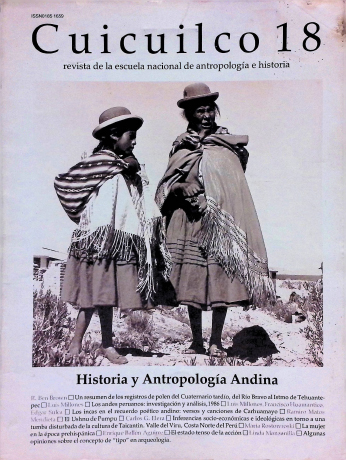Un resumen de los registros de polen del cuaternario tardío, del Río Bravo al Istmo de Tehuantepec
Keywords:
Río Bravo, Itsmo de TehuantepecAbstract
Este artículo resume los registros de polen del cuaternario tardío, marinos, arqueológicos y lacustres, que han sido recuperados del Río Bravo al istmo de Tehuantepec. En tanto que la calidad y presentación de los datos varían grandemente, deben sacarse las siguientes conclusiones: antes de 9500 A.P. los registros marinos de polen indican un medio ambiente árido que hacia 6500/5500 años A.P. dio lugar a un periodo de muy variadas condiciones de humedad y a un gradiente relativo, frío-tibio, de sur a norte. De 6500/5500 a 3000 años A.P. los registros marinos de polen sugieren condiciones más húmedas y posiblemente más tibias. Después de 3000 a.os A.P. el registro de polen del Golfo de California es interpretado indicando una tendencia desecante o una tendencia decreciente en las lluvias de verano, mientras que de 3000 a 2000 años A.P. el registro de polen de la costa de Guerrero indica un periodo de humedad, y el registro de polen de la costa de Oaxaca indica un periodo seco. Después de los 2000 años A.P. el registro marino de polen es más coherente, sugiriendo un periodo árido entre los ca. 2000 y 1800 a.os A.P., seguido por un periodo de humedad que duró hasta ca. 700-1000 años A.P. Los últimos 700-1000 años son interpretados como un periodo de relativa aridez. El registro arqueológico de polen indica un patrón de altos niveles del compuesto cheno-am y de polen de pasto, que están asociados con los altos niveles de disturbio asociados a la última expansión preclásica y a la fase intermedia entre el clásico tardío y el postclásico temprano. El registro lacustre de polen es el más extenso e indica un cambio de condiciones de frío y seco a tibio y húmedo alrededor de 12000 a.os A.P. en el núcleo de Texcoco, y 9500 en otras muestras, que contin.a hasta ca. 6500 años A.P. A partir de los 6500 a.os A.P. hay paleoecoloun aumento en la humedad que continúa hasta 5000/ 4500 años A.P. en la mayoría de los sitios, y hasta 3500/3000 años A.P. en los sitios más orientales. La mayor parte de los sitios presentan aridez desde 5000/4 500 años A.P. hasta 3500/3 000 A. P. Después de 3 500/ 3000 años A.P. el polen de maíz es ubicuo y el gran disturbio humano asociado al surgimiento de la civilización mesoamericana es indicado por incrementos del compuesto cheno-am y de polen de pasto. En las zonas centrales la gran perturbación humana continuó hasta los tiempos modernos, pero cambió en la periferia hacer alrededor de 1000 años. Juntos, estos registros de polen indican un medio ambiente frío y seco antes de los 9500 años A.P., que se volvió más húmedo y más tibio hacia los 6000 años A.P. De ca. 6000 a 3000 años A.P. las condiciones de humedad y temperatura son bastante variadas. Después de 3 000 años A.P. el disturbio humano domina el registro lacustre y arqueológico, aunque el registro marino indica periodos de aridez de ca. 2000 a 1800 años A.P. y de ca. 1000 años A.P. a la actualidad, con un periodo intermedio de humedad.
Downloads
References
ADAMS, D.P. (1964) Exploratory Palynology in the Sierra Nevada, California. Interin Research Report. #4, Geochronological Laboratories, University of Arizona.
ADAMS, R.E.W. (1977) Prehistory in Mesoamerica. Little, Brown, Boston.
BARKLEY, F.A. (1934) The Statistical Theory of Pollen Analysis. Ecology, 15:283-289.
BARTLETT, A.S., BARGHOORN, E.S., and BERGER, R. (1969) Fossil Maize from Panama. Science, 152:642-643.
BATALLA, M.A. (1940) Estudios morfológicos de los granos de polen de las plantas vulgares del Valle de México. Published M.A. thesis, Departamento de Biología, Facultad de Ciencias, Universidad Nacional Autónoma de México.
BEADLE, G.W. (1981) Origin of Corn: Pollen Evidence. Science, 213:890-892.
BRADBURY, J.P. (1971) Paleolimnology of Lake Texcoco, México: Evidence from Diatoms. Lininology and Oceanography, 16:180-200.
BROWN, R.B. (1980) A Preparatory Statement to a.Paleoecological Study on the Northern Frontierof Mesoamerica. Manuscript on file with the Arizona State Museum Library. (1984) The Paleoecology of the Northern Frontier of Mesoamerica Unpublished Ph. D. thesis, Department of Anthropology, University of Arizona, Tucson.
BROWN, R.B., and JACOBS, B.F. In prep. Analysis and Interpretation of the Pollen from two West Mexican Lakes.
BYRNE, R. (1982) Preliminary Folien Analysis of Deep Sea Drilling Project Leg 64, Hole 480, Cores 1-11. Initial Report of the Deep Sea Drilling Project, 64(2):1225-1235.
CALNECK, E.E. (1972) Settlement Pattern and Chinampa Agriculture at Tenochtitlan. Amerícn» Antiquity, 37(l):104-115.
CONNALLY, G.G. (1984) Recyled Fossil Palynomorphs in Marine Sediments. Abstraéis with Programs 1972, 4(7):480. Geological Society of America. 1973 Source and Distribution of Palynomorphs of the Gulf of California. Geosciences and Man, XI:156.
CROSS, A.T., THOMPSON, G.G., and ZAITEFF, J.B. (1966) Source and Distribution of Palynomorphs in Bottom Sediments, Southern Part Gulf of California. Marine
Geology, 4:467-524.
CLISBY, K.H., and SEARS, P.B. (1955) Palynology of Southern North America. III: Microfossil profiles under México City correlated with the sedimentary profiles. Bulletin Geological Society of America. 66:511-520.
DE BUEN, F. (1941) El Lago de Patzcuaro. Instituto Panameño de Geografía e Historia, Revista Geográfica, 1:20-44. (1944) Limnobiología dePátzcuaro. Anales del Instituto de Biología, 15:261-312.
DEEVEY, E.S. (1943) Intento Para Datar Las Culturas Medias Del Valle de México Mediante Análisis de Polen. Ciencia, 4(4 & 5):97-105. 1944 Pollen Analysis and Mexican Archaeology; an attempt to apply the method. American Antiquity, 10:135-149. 1957 Limnological Studies in Middle America. Transactions of the Connecticut Academy of Arts and Sciences, 39:213-328.
DIPESO, C.C., RINALDO, J.B., and FENNER, GJ. (1976) Casas Grandes, Northland Press, Flagstaff, Arizona.
DUFFIELD, R., and KING, J.E. (1979) Sample Size and Palynology: A Midwestern Test. Transactions ofthe Illinois Academy of Science, 72(2):l-7.
FAEGRI, K., and IVERSEN, J. 1975 Tcxtbook of Palynology. Hafner, New York.
FLANNERY, V.K., and SCHOENWETTER, J. (1970) Climate and Man in Formative Oaxaca. Archaeology, 23(2):144-152.
FLORES MATA, G., J. JIMENEZ LOPEZ, X. MADRIGAL SANCHEZ, F. MONCAYO RUIZ, and F. TAKAKI TAKAKI (1971) Tipos de vegetación de la República Mexicana. Secretaría de Recursos Hidrúlicos. México City.
FOREMAN, F. (1955) Palynology in Southern North America. II: Study of Two Cores from Lake Sediments of the México City Basin. Bulletin Geological Society of America, 66:475-510.
GONZALEZ APARICIO, L. (1973) Plano Reconstructivo de la Región de Tenochtitlán. Instituto Nacional de Antropología e Historia. México City.
GONZALEZ-QUINTERO, L. (1980) Paleoecología de un Sector Costero de Guerrero, México (3,000 años). In: Memorias, III Coloquio sobre Paleobotánica y Palinología (Coordinación, Fernando Sánchez). Colección Científica Prehistoria, 86:133-158. Instituto Nacional de Antropología e Historia, México, D.F.
GONZALEZ-QUINTERO, L., and FUENTES MATA, M. (1980) El Holoceno de la porción central de la Cuenca del Valle de México. In: Memorias, III Coloquio sobre Paleobotánica y Palinología. (Coordinación, Fernando Sánchez). Colección Científica Prehistoria, 86:113-132. Instituto Nacional de Antropología e Historia, México, D.F.
HABIB, D., THURBER, D., ROSS, D., and DONAHUE, J. (1970) Holocene Palynology of the Middle American Trench near Tehuantepec, México. Memoirs of the Geological Society of America, 126:233-261.
HANSEN, B.S., and CUSHING, E.J. (1973) Identification of Pine Pollen of Late Quaternary Age from the Chuska Mountains, New México. Bulletin Geological Society of America, 84:1181-1200.
HEUSSER, L.E. (1982) Pollen Analysis of Laminated and Homogeneous Sediment from the Guaymas Basin, Gulf of California. Initial Report of the Deep Sea Drilling Project, 64(2):1217-1223.
HEINE, K. (1973) Variaciones más importantes del clima durante los últimos
,000 años en México. Comunicaciones, 7/1973,51-58. Puebla.
HUNTINGTON, E. (1913) Shifting Climatic Zones As Illustrated in México. Bulletin of the American Geographical Society, 45(1):1-12 and 45(2):107-116. The Climactic Factor as Illustrated in Arid America. Publication No. 192. Carnegie Institute of Washington. Maya Civilization and Climatic Change. XIXth International Congress of Americanists. Washington, D.C.
HUTCHINSON, G.E., PATRICK, R., and DEEVEY, E.S. (1956) Sediments of Lake Patzcuaro, Michoacan, México. Bulletin Geological Society of America, 67:1491-1504.
JACOBS, B.F. (1982) Modern Pollen Spectra from Surface Soil Samples, Northern Nayarit, Southern Sinaloa, México. Journal ofthe Arizona-Nevada Academy of Sciences, 17:1-14.
KELSO, G. (1976) Pollen Analysis of Reservoir 2 and Macaw Nesting Boxes. In: Casas Grandes. (Charles C. DiPeso, John B. Rinaldo and Gloria Fenner, eds.), 4:34-36. Northland Press, Flagstaff, Arizona.
KOVAR, A. (1970) The Physical and Biological Environment of the Basin of México. In: The Natural Environment, Conteniporary Occupation and 16th. Century of the Valley, the Teotihuacan Valley Project Final Report, Vol. 1. Occasional Papers in Anthropology, 3:13-67. Department of Anthropology, Pennsylvania State University, University Park, Pennsylvania.
KUTZBACC, J.E. (1981) Monsoon Climate of the Early Holocene: Climate Experiment with the Earth's Orbital Parameters for 9,000 Years Ago. Science, 214:59-61.
LORZANO, M. DEL S. (1979a) Premiare Approche de l'Analyse Pollinque Dans la Región de San Luis Potosí (Mexique). Docteur de Troisieme Cycle. Université D'Aix-Marseille. (1979b) Atlas de Polen de San Luis Potosí, México. Pollen et Spores, 21(3):287-336.
LUMHOLTZ, C. (1904) El México Desconocido, tomo II. Charles Scribner's Sons, New York.
MACK, R.N. (1971) Pollen Size Variation in Some Western North American Pines as Related to Fossil Pollen Identification. Northwest Science, 45(4):257-269.
MAHLER, L.J. (1972) Nomograms for Computing 0.95 Confidence Limits of Pollen Data. Review of Paleobotany and Palynology, 13:85-93.
MANGELSDORF, P.C. (1974) Corn. Harvard University Press, Cambridge.
MANGELSDORF, P.C., MACNEISH, R.S., and WILLEY, G.R. (1964) Origins of Agriculture in Middle America. In: Natural Environments and Early Cultures (edited by Robert C. West), pp. 413-445. Handbook of Middle American Indians, vol. 1, Robert Wauchope, general editor. University of Texas, Austin.
MARTIN, P.S. (1963) The Last 10,000 Years. University of Atizona, Tucson, Atizona.
METCALFE, S„ and HARRISON, H.E. (1983) Preliminary reconstruction of the Late Quatcrnary environmental changes as recorded by lake margin deposits in The Basin of Zacapu, Michoacán. Ms. on file, The Tropical Paleoenvironments Research Group, School of Geography. University of Oxford, Oxford.
MEYER, E.R. (1973) Late Quaternary Paleoecology of the Cuatro Ciénegas Basin, Coahuila. México. Ecology, 54(5):982-995. (1975) Vegetation and Pollen Rain in the Cuatro Ciénegas Basin, Coahuila, México. The Southwestern Naturalist, 20(2):215-224.
NIEDERBERGER, C. (1976) Zohapilco. Colección Científica Arqueología, No. 30. Instituto Nacional de Antropología e Historia, México City.
NIEDERBERGER, C. (1979) Early Sedentary Economy in the Basin of México. Science, 203:131-140.
OHNGEMACH, D. (1973) Análisis polínico de los sedimentos del pleistoceno reciente y del holoceno en la región de Puebla-Tlaxcala. Comunicaciones, 7/1973:40-45. (1977) Pollen sequence of the Tlaloqua cráter (La Malinche Volcano, Tlaxcala, México). Boletín déla Sociedad Botánica de México, 36:33-40.
OHNGEMACH, D., and STRAKA, H. (1978) La Historia de la Vegetación de la región de Puebla-Tlaxcala durante el cuaternario tardío. Comunicaciones, 15/1978:189-204.
PALACIOS CHAVEZ, R„ and ARRENQUIN, M. DE LA L. 1980 Análisis polínico de algunos sitios de interés arqueológico en el Valle de San Juan del Río, Querétaro. In: Memorias, III Coloquio sobre Paleobotánica y Palinología. (Coordinación Fernando Sánchez). Colección Científica Prehistoria, 86:179-184. Instituto Nacional de Antropología e Historia, México, D.F.
POLLARD, H.P. (1979) Paleoecology of the Lake Patzcuaro Basin: Implications for the Development of the Tarascan State. Paper presented at the 43rd International Congress of Americanists, Vancouver. Central places and cities: a consideration of the protohistoric Tarascan State. American Antiquity, 45:677-696. Water and Politics Paleoecology and the Centralization of the Tarascan State. Paper presented at the 44th International Congress of Americanista, Manchester.
PUIG, H. (1976) Vegetation de la Huasteca, Mexique. Mission Archeologique et Ethnologique Francaise au Mexique. Collection de Eludes Mesoamericaines, No. 5. México City. (1979) Notice de la feuille Guadalajara-Tampico. Carte Internationale du Tapis Vegetal. Extrait des Travaux de la Section Scientifique et Technique de l'Institut Frangís de Pondichéry. Hors serie No. 16-1979. Instituí Frangais Pondichéry, India.
RAYNOR, G.S., OGDEN, E.C., and HAYES, J.V. (1972) Dispersión and Deposition of Corn Pollen from Experimental Sources. Agronomy founial, 64:420-427
RZEDOWSKI, J. (1966) Vegetación del Estado de San Luis Potosí. Acta Científica Potosina, 5(1 & 2):1-291. (1981) La Vegetación de México. Limusa. México City.
RZEDOWSKI, J., and MCVAUGH, R. (1966) La Vegetación de Nueva Galicia. Contributions of the University of Michigan Herberium, 9:1-123. Southern Illinois University, Carbondale, Illinois.
SANDERS, W.T., PARSONS, J.R., and SANTLEY, R.S. (1979) The Basin of México. Academic Press, New York.
SCHOENWETTER, J. (1974) Pollen Records of Gu?ila Naquitz Cave. American A>1-tiquity, 39(2):292-303.
SCHULMAN, E. (1944) The Possibilities of Dendrochronology in México. El Norte de México y el Sur de Estados Unidos, pp. 305-307. México City.
SCOTT, S.D. (editor) West Mexican Prehistory, part. 1. Department of Anthropology, State University of New York at Buffalo. West Mexican Prehistory, part 2. Department of Anthropology, State University of New York at Buffalo. West Mexican Prehistory, part 3. Department of Anthropology, State University of New York at Buffalo. West Mexican Prehistory, part 4. Department of Anthropology, State University of New York at Buffalo. West Mexican Prehistory, part.5. Department of Anthropology, State University of New York at Buffalo. West Mexican Prehistory, part 6. Department of Anthropology, State University of New York at Buffalo. West Mexican Prehistory, part 7. Department of Anthropology, State University of New York at Buffalo. (1974) West Mexican Prehistory, part 8. Department of Anthropology, State University of New York at Buffalo.
SAUER, C.O., and BRAND, D.D. (1932) Azatlan. Ibero-Americana, #1.
SEARS, P.B. (1947) Notes on correlated pollen profiles and glacial substages. Revista Mexicana de Estudios Antropológicos, 9(1, 2 & 3):165-168. 1948 Forest sequence and climactic change in northeastern North America since early Wisconsin time. Ecology, 29:326-333. (1951a) Palynology in North America. Svcnsk Botanisk Tidskrift, 45(1 ):241 -246. (1951b) Pollen profiles and culture horizons in the Basin of México. 29th International Congress of America nists, 1:57-61. University of Chicago. El Análisis de Polen en la Investigación Arqueológica. Tlatoani. 1(3 & 4):29-30. Palynology in Southern North America. I: Archaeological horizons in the basins of México. Bidletin of the Geological Society of America, 63:241-254. (1953a) An Ecológica! View of Land Use in Middle America. CEIBA, 3:157-165. (1953b) The Interdependence of Archaeology and Ecology with Examples from Middle America. Annals fo the New York Academy od Sciences, Series II, 15:113-117. (1955) Palynology in Southern Northern America. Introduction and Acknowledgements. Bidletin ofthe Geological Society of America, 66:471-474.
SEARS, P.B., and CLISBY, K.H. (1952) Two long climactic records. Science, 166:176-178. (1955) Palynology of Southern North America. IV: Pleistocene Climate in México. Bidletin of the Geological Society of America, 66:21-530.
SIRKIN, L. (1974) A Palynologic Model for Reconstructing Vegetation and Environments in the Marismas Nacionales, Sinaloa, México. In: West Mexican Prehistory, 8:22-32. Stuart Scott, editor. (1984) Late Pleistocene Stratigraphy and Environments of the West Mexican Coastal Plain. Neotectonics and Sea Level Variations in the Gulf of California Area, a Symposium (V. Malpica-Cruz, S. Celis-Gutiérrez, J. Guerrero-García and L. Ortlieb, editors). Instituto de Geología, Universidad Nacional Autónoma de México.
SIRKIN, L., and GILBERT, D. (1980) Holocene Palynology of the West Mexican Coastal Plain 1. The Teacapan Estuary Región. Palynology, 4:252.
STREET-PERROT, F.A., PERROT, R.A., and HARKNESS, D.D. (1982) Holocene Environments and Man in Central Mexico-Some Preliminary Results. Paper presented al the 44th International Congress of Americanista, Manchester.
TING, W.S. (1965) The saccate pollen grains of Pinaceae mainly from California. Grana Palynologica, 6:270-289. Determination of Pinas species by pollen statistics. University of California Publications in Geological Science, No. 58.
VAILLANT, G.C. (1944) The Aztecs of México. Doubleday, Doran and Co., New York.
VAN DEVENDER, T.R. (1979) Reconstruction of late Pleistocene and Holocene vegetation and climate in the Chihuahuan Desert. Research proposal submitted to the Climate Dynamics Office of the National Science Foundation, Washington, D.C.
WATTS, W.A., and BRADBURY, J.P. (1982) Paleoecological Studies at Lake Patzcuaro on the West-Central Mexican Plateau and at Chalco in the Basin of México, Quaternary Research, 17(l):56-70.
WILSON, D. (1974) The New Archaeology. New American Library. New York.
ZEEVAERT, L. (1952) Estratigrafía y problemas de ingeniería en los depósitos de arcilla lacustres de la ciudad de México. Revista Ingeniería, 25(l):12-28.
Downloads
Published
How to Cite
Issue
Section
License
Copyright (c) 1987 Instituto Nacional de Antropología e Historia

This work is licensed under a Creative Commons Attribution-NonCommercial 4.0 International License.







